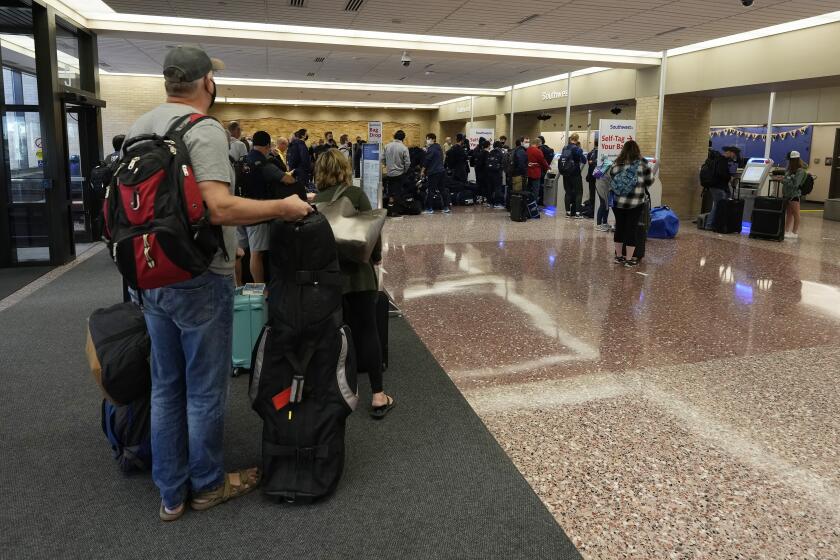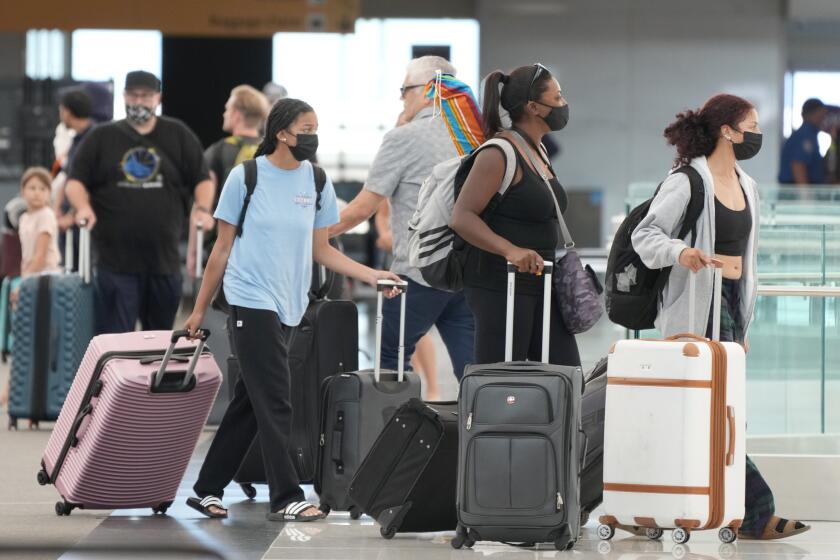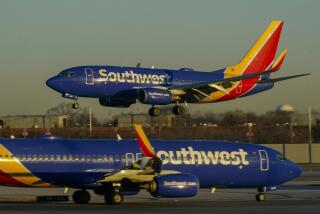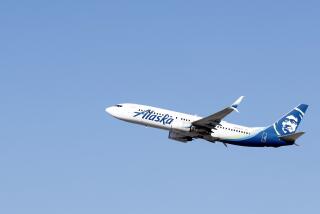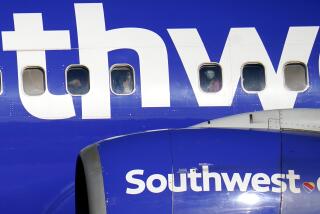Airline seats have been getting smaller for years. Is the shrinking coming to an end?
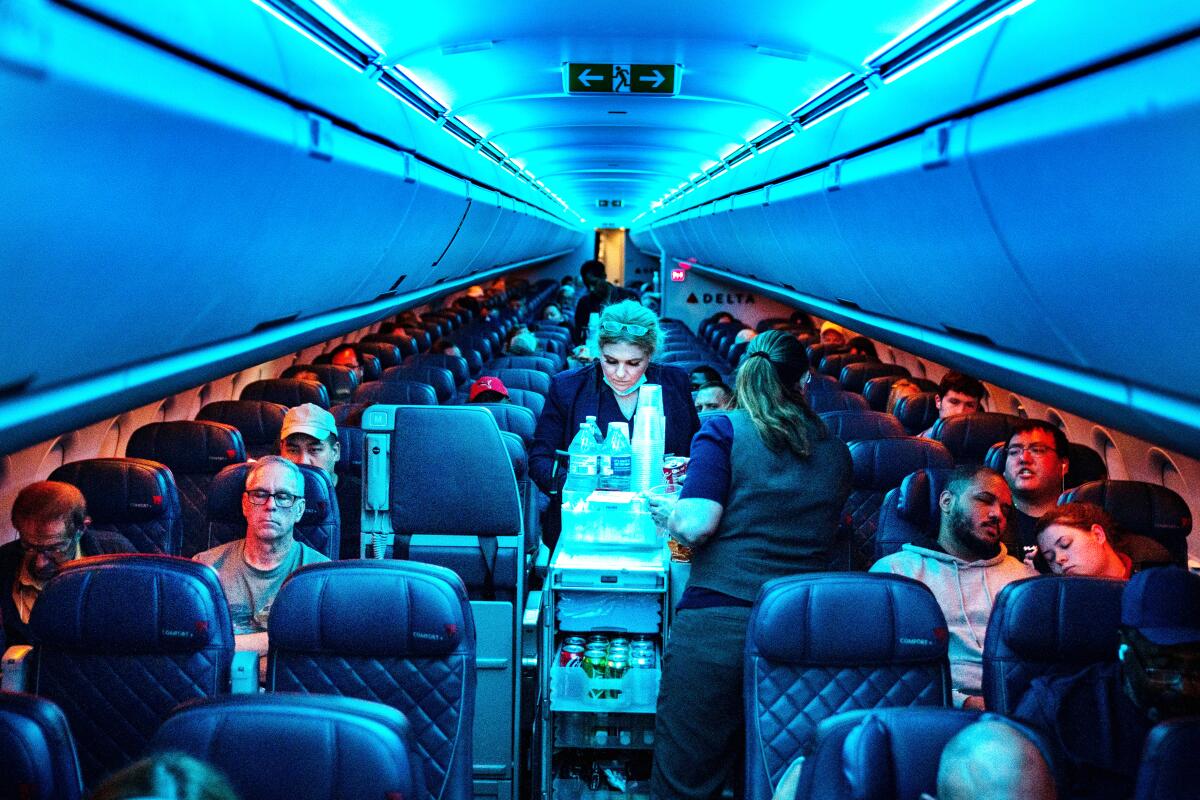
- Share via
Over the last 15 years or so, airlines have found a new way to drive up revenue: squeezing more seats into each plane.
The result has been frustration and pushback from passengers who now endure narrower airline seats with less legroom.
But relief may be in sight: After years of delays, federal regulators have begun taking public comments on a proposal to impose minimum standards on airline seat width and legroom to put a halt to the many years of seat shrinkage.
The standards are needed, say passenger rights advocates, to ensure that passengers are not in agony during long flights and are able to escape a plane quickly in the case of an emergency. Airlines are opposed to any standards, saying studies have shown that seat sizes don’t affect how fast passengers get out of an airplane in a catastrophe.
The U.S. Department of Transportation does not impose any standards for seat legroom, width or comfort. Instead, the federal government allows airlines to cram any number of seats into a cabin, in whatever size, as long as passengers can evacuate in an emergency within 90 seconds. It’s a standard that has been in place since the 1990s.
Over the last decade, airlines have reduced legroom — what the airline industry refers to as “pitch”— to accommodate more seats per cabin. Since 2011, the average seat pitch — the distance between the back of one seat and the back of the next — has dropped from 35 inches to 31 inches, according to a passenger rights group. Ultra-low-cost carriers, such as Spirit Airlines, have reduced the pitch on many seats to 28 inches.
The process has allowed airlines to collect more passenger revenue, making up for fuel prices that began to soar starting in 2008.
But health studies have shown that since the late 1980s, the average American man over age 20 has gained about 15 pounds and his waist size has increased by more than 2 inches. The average American woman over age 20 has gained about 16 pounds and increased her waist size by more than 3 inches.
The U.S. Department of Transportation proposed rule changes Wednesday to make it easier for airline passengers to collect refunds for canceled or delayed flights.
Passenger advocates say the realities in an airplane are different today from in the 1980s. More American passengers have disabilities, and passengers tend to carry multiple electronic devices on planes — including earplug and power cables — and more carry-on luggage to avoid checked baggage fees. These changes, passenger advocates say, make evacuating a plane with cramped seats more difficult.
“We are focused on making sure the minimum seat size reflects the reality of flying today,” said John Breyault, vice president of the National Consumer League, one of several consumer groups pushing for the new standards.
Paul Hudson, president of Flyers Rights, a nonprofit airline passenger rights group, said he plans to file a proposal for airline seat standards in the next few weeks because most Americans can’t fit into typical airline seats without squeezing up against an adjacent passenger or hanging into the middle aisle.
The nation’s flight attendants are calling for the Federal Aviation Administration to set seat standards.
“Flight attendants are left to manage the frustrations of passengers jammed into ever-shrinking space,” said Sara Nelson, president of the Assn. of Flight Attendants-CWA, representing nearly 50,000 flight attendants at 19 airlines. “This is not an issue the market will fix.”
Representatives for the airline industry say there is nothing wrong with the airline seat status quo.
Hannah Walden, a spokesperson for Airlines for America, a trade group for the nation’s largest carriers, said the FAA has “affirmed that all U.S. carriers meet or exceed federal safety standards regarding seat size, and the FAA continues to approve seat configurations before they go into service.”
France-based Airbus suggested a few years ago that the industry should at least adopt a comfortable standard for the seat width. The plane manufacturer released a study that says a minimum seat width of 18 inches improves passengers’ sleep quality by 53%, compared with 17-inch-wide seats.
The summer travel season has been chaotic. Industry insiders put much of the blame on airline executives who scheduled thousands of extra flights to cash in on demand.
If the FAA imposes standards that force airlines to give passengers more elbow and leg room, some airlines — particularly low-cost carriers — may be forced to raise prices or charge higher baggage fees to make up for the loss of revenue from having fewer passengers crammed into each cabin, said Henry Harteveldt, an aviation analyst with Atmosphere Research Group.
The FAA will continue to accept public comment until Nov. 1, either online or via mail sent to Docket Operations, M-30; U.S. Department of Transportation, 1200 New Jersey Ave. SE, Room W12-140, West Building Ground Floor, Washington, D.C. 20590-0001.
So far, the federal agency has received nearly 5,000 comments, mostly from fliers with gripes about the size of seats and legroom offered on airlines.
“I feel like I’m not all that large. I wear a size 8 jeans, size 10 dress and I feel like if I got the littlest bit bigger I wouldn’t fit,” wrote one commenter from San Jose. “And I hate how my bigger friends are treated when they try to fly. If left to the airlines they would have us standing up in order to park more people onto the plane.”
An airline traveler from Arcadia also suggested in a submission that the FAA needs to impose seat standards “before the airlines have us all standing like cattle on a transport!”
“Profits over comfort at all costs is now beyond ridiculous!” the commenter wrote.
Seat size and legroom is a concern for fliers with disabilities, said Eric Lipp, executive director of the Open Doors Organization, a nonprofit that promotes the rights of travelers with disabilities. Cramped seats make it harder for travelers who are larger because of a disability or who travel with a service dog to fly on a commercial plane, he said.
The debate over standard seat size has been brewing for years, with airlines pushing hard to keep the government from regulating the size of seats and the legroom between them. Under pressure from frustrated passengers and consumer advocates, Congress instructed the FAA in a 2018 financing bill to consider adopting seat standards.
In response to the directions from Congress, the FAA conducted a series of evacuation tests, using 775 volunteers in several simulated airline cabins at a test facility in Oklahoma. The volunteers varied in size, age and weight but most of them were heavier than the average American traveler because “the Oklahoma population is typically larger, heavier, and can be assumed to be slower than the average U.S. population,” according to the FAA study.
In some evacuation tests, the volunteers were offered extra money as motivation to be among the first to evacuate during the simulated evacuations.
Some of the tests used seats with a 28-inch pitch, among the narrowest found in the industry. The results “indicate that evacuations at a narrow seat pitch are safe for virtually all (99%) of the able-bodied population,” according to the study.
The FAA study added this caveat: “The study results do not consider passenger comfort (or the lack thereof), which impacts a passenger’s sense of well-being during a flight.”
Passenger advocates like Breyault question the ability of such studies to accurately gauge what would happen in a real-life scenario.
“Physics tells you the more people you pack into a plane the longer it will take to evacuate,” he said. “It’s hard to believe the current seat sizes are safe.”
More to Read
Inside the business of entertainment
The Wide Shot brings you news, analysis and insights on everything from streaming wars to production — and what it all means for the future.
You may occasionally receive promotional content from the Los Angeles Times.
